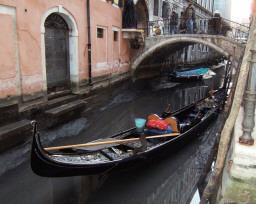Waterbuses on Venice's Grand Canal are at risk of getting stuck in the mud this week as the city suffers from its annual bout of low tides.
The lagoon city tends to run dry for a week each winter, and on Monday tides were as much as 80 cm below normal.
This has resulted in the smaller canals drying up almost completely, exposing sludgy canal beds and leaving many of the city's picturesque gondolas stranded.
Venice periodically has lower tides than normal, usually during a drought or because of atmospheric pressure affecting water conditions.
The all-time record low was set in 1934, when the tide was 121 cm below average.
But the city built on mud islands in a lagoon at the top of the Adriatic Sea is more famous for the opposite problem, and it has been known for years that Venice is sinking into the sea.
Flooding from high tides is a constant reality for residents, and St Mark's Square - a must on Italy's tourist trail - is covered with water dozens of times a year.
Tides in the city reached an annual high of 109 cm above normal in November last year, although it was spared the severe flooding that occurs when tides hit the 110 cm mark.
Experts say high water in Venice is the result of three principle factors: the rising floor in the lagoon caused by incoming silt; the undermining of the islands by the extraction of methane gas in the sea off Venice; and the overall increase in sea levels caused by global warming.
These conditions can then be aggravated by high winds and the cycle of the moon.
In a bid to combat flooding, a 4.1-billion-euro flood barrier system is being built to block the lagoon from the Adriatic Sea when high tides are forecast.
The system is slated for completion in 2010.













